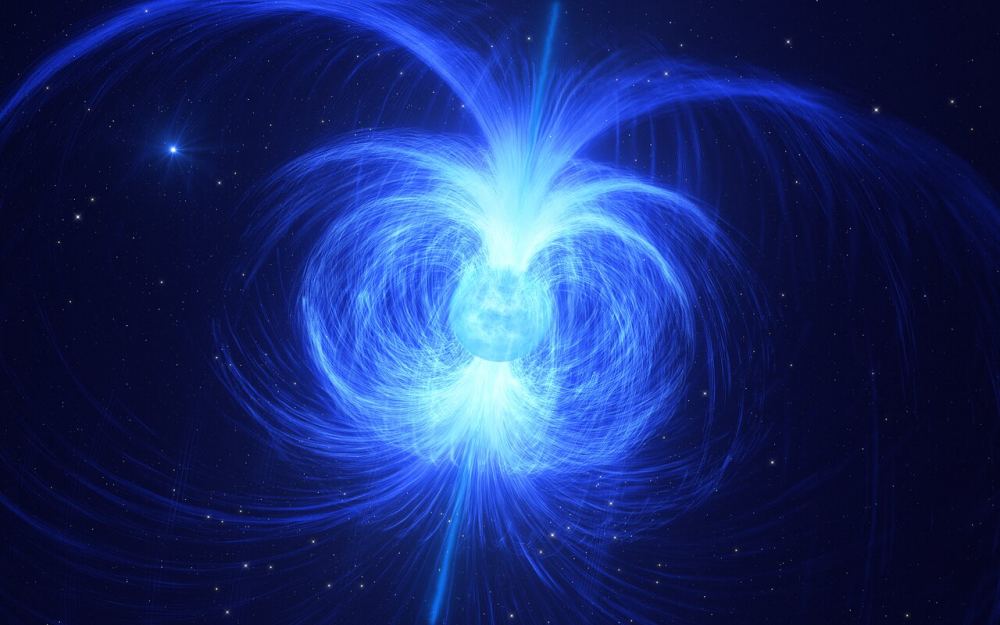Imagine a living star with a magnetic field at least 100,000 times stronger than Earth’s field. That’s the strange stellar object HD 45166. Its field is an incredible 43,000 Gauss. That makes it a new type of object: a massive magnetic helium star. In a million years, it’s going to get even stranger when it collapses and becomes a type of neutron star called a “magnetar”.
According to astronomer Tomer Shenar (University of Amsterdam), HD 45166 provides clues to the creation of magnetars. He’s the head of a team looking at this strange object. Their observations show that this object is no ordinary massive star. Instead, they think it is what’s left after the merger of two lower-mass helium stars.
“Some of their mass was lost during the merging process,” he said in an email. “The result is this heavily magnetized helium star which mimics the core of a star that was originally 8 times more massive than our Sun—massive enough to explode as a supernova and collapse into a neutron star.”

The newly formed helium object is a highly evolved Wolf-Rayet star. Before it becomes a magnetar, it has to go through some more changes. Stellar evolution models suggest that it will eventually explode as a type Ib or IIb supernova. As it collapses under its own gravity, the already-strong magnetic field will grow. Eventually, the object will become a very compact core with a magnetic field of around 100 trillion Gauss. That would make it one of the most powerful types of magnet in the Universe: a magnetar.
Studying the Progenitor for Clues
HD 45166 is actually a stellar pair, of which the Wolf-Rayet star is one member. Astronomers have observed it for more than a century, but its strange characteristics defied explanation. Shenar and research colleague Julia Bodensteiner (of Katholieke Universiteit in the Netherlands) decided to look more deeply into its oddities. “This star became a bit of an obsession of mine,” said Shenar, who has studied other helium-rich stars. He began to wonder if a strong magnetic field could explain what he and others knew about this object.
Magnetic fields play an important role in events and objects throughout the universe. They certainly influence behavior throughout a star’s life. So, it’s not surprising to consider magnetic fields when confronted with a stellar mystery. “I remember having a Eureka moment while reading the literature: ‘What if the star is magnetic?’” said Shenar.
To research that idea, and to see if this object is a proto-magnetar, Shenar and his colleagues requested and got time on several telescopes. The main observations occurred in February 2022. The team used an instrument on the Canada-France-Hawaii Telescope that can detect and measure magnetic fields. They also relied on archival data taken with the Fiber-fed Extended Range Optical Spectrograph (FEROS) at ESO’s La Silla Observatory in Chile. That’s how the team found out the star had a magnetic field strength of 43 kiloGauss. “The entire surface of the helium star has a magnetic field almost 100,000 times stronger than Earth’s,” said team member Pablo Marchant, an astronomer at KU Leuven’s Institute of Astronomy in Belgium.
This observation marks the discovery of the very first massive magnetic helium star. “It is exciting to uncover a new type of astronomical object,” says Shenar, ”especially when it’s been hiding in plain sight all along.”
How Do Magnetars Form?
The discovery of HD 45166’s strange origins gives another tantalizing clue to the origins of magnetars. These objects are really strange denizens of the cosmic zoo. Magnetars are neutron stars, the hot leftovers from the deaths of supermassive stars. Essentially, neutron stars are the cores of the once-living supermassive stars. They’re no longer stars with nuclear fusion going on in their cores. Instead, these beasts are spinning spheres of condensed neutrons packed together incredibly tightly. All that mass has very strong gravity. And, something inside is generating a magnetic field that is trillions of times stronger than Earth’s.

Magnetars go one step further and generate magnetic fields a thousand times stronger (at least) than their progenitor neutron stars. The process probably comes from a magnetohydrodynamic process in conducting “fluids” inside the star. This is roughly similar to what happens in the turbulent center of our planet. Like their neutron star predecessors, magnetars likely have solid, crusty surfaces.
Astronomers continue to probe these objects for clues to the origins of their hefty magnetic fields. As far back as 2009, they entertained the idea that stellar mergers could create conditions for such strong fields. According to Shenar, the origin of the magnetic field in HD 45166 probably goes back to the process that created the proto-magnetar. It gave rise to the hefty magnetic field, which he says “got frozen” into the layers of the star. That field will be the hallmark of the future magnetar.
At least 29 known magnetars exist in the Milky Way Galaxy, visible to us through their X-ray and gamma-ray emissions. Eventually, the magnetic fields relax and fade and the emissions stop. That leaves behind a dead core. It’s likely that our galaxy likely has tens of millions of inactive magnetars.
For More Information
New Type of Star Gives Clues to Mysterious Origin of Magnetars
How Mergers Magnetise Massive Stars
A Massive Helium Star with a Sufficiently Strong Magnetic Field to Form a Magnetar

